This was published 9 months ago
How Epstein wheedled his way into Bill Gates’ world – and why Melinda hated it
It wasn’t just former US presidents and British royalty who were tarnished by their association with the late sex offender Jeffrey Epstein. Billionaire Bill Gates also took a reputational hit – one that contributed to the collapse of his marriage.
By Anupreeta Das
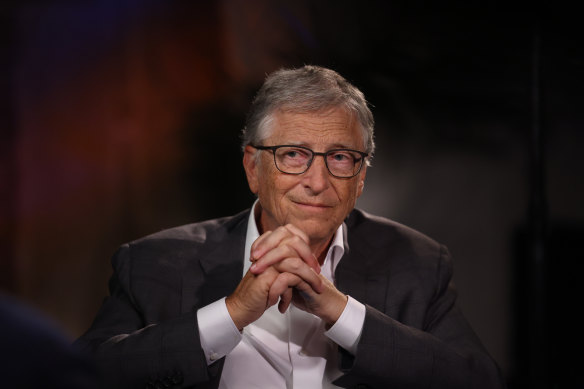
Jeffrey Epstein heard about the unanticipated outcome of the Giving Pledge for the Gates’ foundation and began to tunnel a way into the philanthropist’s orbit. Credit: Bloomberg via Getty Images
There is a photograph of Bill Gates – easily searchable on the internet, unmissable as a billboard – in which the Microsoft co-founder and billionaire philanthropist is standing facing the camera, his lips pressed into the service of a smile. There are four other men in the picture, taken in May 2011. Gates is second from right, dressed in a blue collared shirt and one of his usual sweaters. To his left stands a man with a buzz cut. To his right, at the centre of the photograph, is a man with a tousled mop of salt-and-pepper hair, his arms folded. He is dressed in blue jeans and a half-zip sweater, the left arm of which is emblazoned with the American flag. On his feet are velvet slippers.
This man is Jeffrey Epstein, the convicted sex offender, social parasite, poseur and pariah who died by his own hand in a Manhattan jail cell in August 2019. A month earlier, federal authorities had charged Epstein with sex trafficking of girls as young as 14, and the world was learning of his lurid activities and the astonishing array of high-profile men in his network. Of all the stars that studded Epstein’s dark universe, from academics and entertainers to bankers and billionaires, Gates was the brightest. He was also the most mystifying. Here was one of the most recognised names and faces in the world, a visionary technologist who helped kickstart the computing revolution, and a path-blazing philanthropist with the lofty ambition of saving lives. Why was a deity of capitalism consorting with one of its Mephistophelian bottom-feeders?
There was no convenient label to affix to the relationship between Gates and Epstein, and no label would have hidden the smudges that began to blur the clear, unsullied outlines of the technology billionaire’s do-gooder image. The photograph, which surfaced in 2019, accompanied a story by The New York Times detailing multiple meetings between the two men. Two years later, in the middle of the coronavirus pandemic, Melinda Gates, his wife of 27 years, would divorce him. Theirs had sometimes been a difficult marriage; for years, talk of Gates’ womanising had whirred in the background among those who worked with the former couple. But the public airing of his relationship with Epstein contributed to their break-up. As if to symbolically distance herself from the man who had betrayed her, even though she was tied to him forever by their shared philanthropy, Melinda inserted her maiden name in between her first and last names. She would now go by Melinda French Gates.
Not long after their divorce, the world learnt about the affairs he had conducted during his marriage. Once a model of rectitude, Gates had fallen into a slurry of ignominy. The large tear in Gates’ public image has forced us to reassess the man we knew, or thought we knew, a man so brilliant, so rich and so munificent that he had for decades been feted and festooned like a king wherever he went.
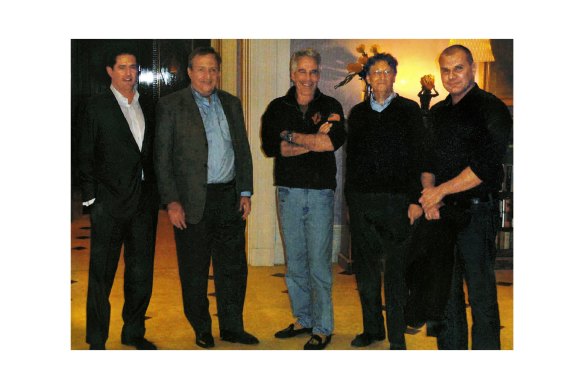
Bill Gates (second from right) next to convicted sex offender Jeffrey Epstein (centre) in Epstein’s apartment in 2011.
When Warren Buffett, Bill Gates and Melinda French Gates announced the Giving Pledge in June 2010, publicly committing to give at least half their wealth back to society during their lifetimes or in their wills, and urging other billionaires to do the same, Jeffrey Epstein saw a way to make money. Two years earlier, the registered sex offender had pleaded guilty to soliciting prostitution, including from an underage girl, following his 2006 arrest. After serving a light, work-release sentence in a Florida jail, he resumed what he had done for more than a decade: cultivating a network of scientists, musicians, bankers, Nobel laureates, politicians, billionaire businessmen, academics, filmmakers – just about anyone with influence who could give him a sheen of legitimacy by association, a valuable introduction, a piece of information he could keep in his back pocket to be wielded in exchange for a favour. Tucked in between haircut appointments at the upscale Frédéric Fekkai salon and massage appointments were endless meetings, video calls, private jet trips, dinners and cocktails.
An egregious name-dropper, Epstein was fully aware that the more names he dangled and the more connected he was to people, the more accepted he would be in those rarefied circles, where the best vetting mechanism was a friend-of-a-friend introduction. Out of his multiple residences, including in New York and Palm Beach and on Little St James, his private island in the US Virgin Islands, Epstein conducted his business and was welcomed by those he courted, his sordid background reduced to a footnote.
Epstein heard about the unanticipated outcome of the pledge for the [Gates Foundation] and began to tunnel a way into the philanthropist’s orbit.
The Giving Pledge had created an enormous splash. The star power of two of the richest and weightiest billionaires made the effort hard to ignore. Buffett’s commitment to give the bulk of his fortune during his lifetime to the Gates Foundation, through which Gates and French Gates were tackling some of humanity’s most intractable problems, gave them the moral authority to ask other billionaires to step up. By August 2010, 40 billionaires and billionaire couples had signed the pledge. By year’s end, 17 more had joined the group. At the same time, some who had taken the pledge began to wonder: how to disburse that money? Many billionaires had private foundations, but they were often modest, family affairs. Building a foundation to hand out big sums of money is a significant undertaking akin to launching a new business.
Some billionaires thus turned to Gates, the one person who already had a massive operation going, wondering if they could partner up with his foundation in some way, or have it direct their money. Connected as he was to scientists, billionaires and Gates’ trusted lieutenants, Epstein heard about the unanticipated outcome of the pledge for the foundation and began to tunnel a way into the philanthropist’s orbit.
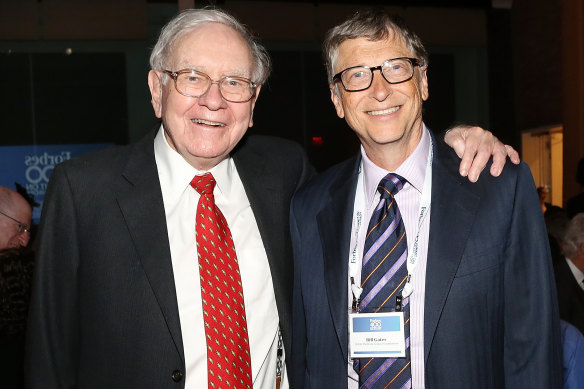
Gates and Warren Buffett (left) pledged in 2010 to give at least half their fortunes away, opening the door to an Epstein plot.Credit: WireImage
One evening in January 2011, not long after a blizzard had menaced the city of New York, Epstein hosted a dinner at his Upper East Side townhouse for Gates, pitching the evening to some invitees as a relaxed gathering with a group of influential people. It was the kind of gathering Epstein excelled at – entertaining and stimulating, a setting where social chatter mixed seamlessly with business talk. Gates appeared to find it an enjoyable evening. That May, Epstein hosted another meeting for the philanthropist. Among the guests were Larry Summers, the former US secretary of the treasury and president emeritus of Harvard University; and James E. Staley, a former senior executive of J.P. Morgan Chase.
Epstein used the opportunity to present an idea to Gates, and even included slides: could some of the billionaire philanthropic dollars being pledged be pooled into a charitable fund created for the Gates Foundation? Such donor-advised funds are vehicles created by banks and other big asset managers into which wealthy individuals can deposit money that they eventually plan to give to charity. Donors get to decide the causes they want to direct their philanthropic funds to, but until they do, the money managers oversee the funds for a fee.
For years, some employees in the Gates orbit had made it an informal goal to push their boss’s name for the Nobel Peace Prize.
Gates was receptive to the idea, emboldening Epstein to begin pushing his proposal more steadily. He roped in J.P. Morgan, the nation’s largest bank where he was a client, to set up a donor-advised fund for the Gates Foundation, which would “enhance the current giving” by the outfit. Bank executives were already in touch with foundation staffers about a separate project, which led to the creation of a healthcare fund in 2013. Epstein had long been friends with Staley, who goes by Jes, at the time a top lieutenant of J.P. Morgan’s chief executive Jamie Dimon.
Over hundreds of emails studded with typographical errors sent to J.P. Morgan executives including Mary Callahan Erdoes, who led the bank’s private wealth and asset management business, Epstein laid out his ambitions for the donor-advised fund. It would be a “very high profile” club with an entry donation of $US100 million. Like other donor-advised funds, this one too would provide donors the tax benefits up front. The proposed structure would involve silos – areas that the Gates Foundation focused on, such as polio, maternal health, vaccines and agriculture – that donors wanted to direct their money into. Membership to this donor club would be known, but donors could choose to remain anonymous about how they directed their money.
Even a cursory search of Epstein in any database of archived news – or a simple Google search – would reveal enough stories about his questionable behaviour and habits to raise red flags. In a 2003 profile in Vanity Fair, the journalist Vicky Ward wrote: “His advantage is that no one really seems to know him or his history completely or what his arsenal actually consists of. He has carefully engineered it so that he remains one of the few truly baffling mysteries among New York’s moneyed world. People know snippets, but few know the whole.” The profile mentions that he left Bear Stearns, the investment bank where he got his start, under a cloud. But Ward also reported that billionaires like Tom Pritzker, the chairman of Hyatt Hotels; the real estate mogul Mort Zuckerman; businessman Ron Perelman; and billionaire private equity investor Leon Black, who it would later emerge had paid $US158 million in fees to Epstein for tax advice, would often stop by his house for dinner.
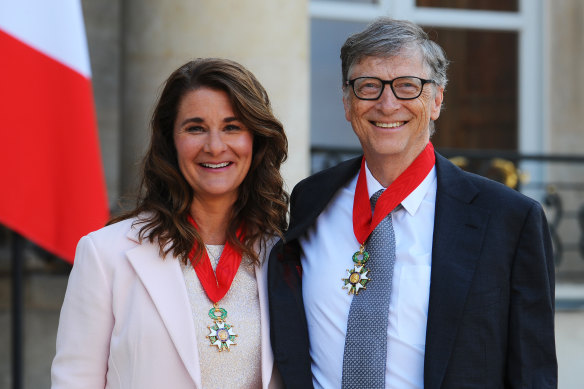
Melinda French Gates with ex-husband Bill. She’s said his relationship with Jeffrey Epstein contributed to their divorce.Credit: Getty Images
Epstein appeared occasionally in gossip pages and was routinely referred to as a billionaire (even though he was not), a connoisseur of women, a financier with a small roster of billionaire clients, a property developer, or an employee of Wexner. There were always gossipy tales of multiple young women, particularly from Eastern Europe, in his life. By the mid-2000s, Epstein was making news for his lifestyle and his failed bids to buy media properties. In a 2005 article about executive assistants on Wall Street, The New York Times described him as someone who maintained an office in New York but lived and worked on a private island in the US Virgin Islands, with a “three-women executive team, which manages his hectic life for globetrotting and hobnobbing with the likes of former president [Bill] Clinton”.
At the same time, there were lawsuits against him, including one with Citibank, which said he had defaulted on $US20 million of loans from their private bank. When he was arrested in Florida in 2006, after multiple underage girls accused him of sexual assault, major media organisations like the Associated Press, The New York Times, The Guardian and various Florida newspapers ran stories. And there was yet another flood of coverage when he pleaded guilty to charges of soliciting prostitution and soliciting prostitution from a minor in 2008.
Some called it the gold prize. For years, some employees in the Gates orbit had made it an informal goal to push their boss’s name for the Nobel Peace Prize. Gates and French Gates had won multiple public service laurels, including the highest honours from countries like India, so it wasn’t a stretch to eye the top prize. It was a “front and centre” goal among some employees at Gates Ventures and the Gates Foundation, according to several people who were aware of those conversations, although another person said he wasn’t aware of any specific strategy conversations during his time at Gates Ventures.
‘The foundation is here to save the world, every life has equal value, and Bill is the frontman.’
A former senior employee of the Gates Foundation
There would be an open and ongoing conversation about how to massage Gates’ so-called brand to appeal to the Nobel Prize committee, and about how the team could opportunistically use global health milestone moments – the potential eradication of polio or breakthroughs in malaria research – where the foundation played a big role to create a media campaign about his candidacy. At the Gates Foundation, it was more chatter and aspiration than a “10-step plan”, according to one former senior employee of the foundation.
Many saw such a prize as validation of the work they had signed up to do. It was especially buzzy as the foundation suddenly began playing an outsize role in global health and development, supercharged by Buffett’s decision in 2006 to turn over billions of dollars to its endowment. The Giving Pledge put him on an even higher pedestal, coming as it did right after the financial crisis, which spotlighted the country’s widening economic inequality.
“Everything was done with an eye to that goal,” said the former senior employee, referring to the Nobel Prize. “That’s why we were positioning in the media and PR as we did. It boiled down to – the foundation is here to save the world, every life has equal value, and Bill is the frontman.”
The unofficial campaign may have been one reason Gates met with Epstein at least once in 2013, according to media reports. Between 2011 and 2014, the Gates Foundation ran a highly visible campaign about its polio-related grant-making. Eradicating polio had been one of Gates’ biggest priorities and the foundation had partnered with Rotary International, the non-profit that was leading those efforts. Foundation staffers were hoping their work would win them the honour. Epstein, who had cultivated a wide network of powerful people, told a former foundation employee that he could help the philanthropist win the award for his work to eradicate polio.
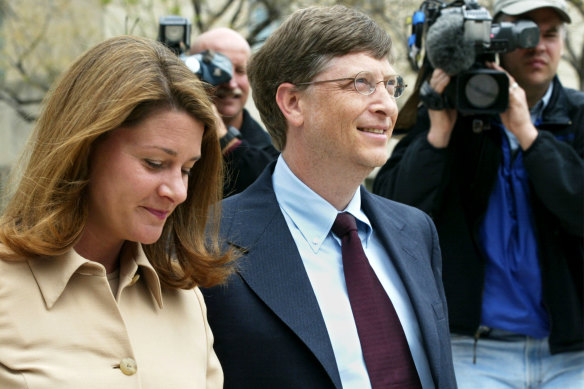
With Melinda, en route to give evidence in the Microsoft antitrust case.Credit: Getty Images
In late March 2013, Thorbjørn Jagland, then the secretary general of the Council of Europe, a human rights organisation, and chairman of the Norwegian Nobel Prize Committee, hosted a dinner for Gates at his official residence in Strasbourg, France. Gates had sought the meeting, Jagland said, to learn more about the European Pharmacopoeia, a body affiliated with the council that oversees quality control for medicines distributed across European markets.
To Jagland, it seemed natural that the philanthropist would be interested in learning about the council’s work, and to the extent he knew, there was no other reason why Gates wanted to meet. Jagland, a former prime minister of Norway, said no one had put forth a Nobel Peace Prize nomination for Gates or the Gates Foundation that year, but he was given to believe that the billionaire brought Epstein to the dinner. “I don’t know why he brought Epstein with him, I was not informed in advance,” Jagland said. Asked about the meeting, Alex Reid, a spokeswoman for Gates Ventures, said that Gates had not brought Epstein to “a meeting with Jagland. If he was there, he was not invited by Bill, nor did he arrive with Bill.”
Also present at the dinner were officials from the International Peace Institute in New York, an independent organisation that sometimes works with the United Nations, and whose president, Terje Rød-Larsen, had had several interactions with Epstein. An influential Norwegian diplomat who played a central role in negotiating the Oslo Accords, Rød-Larsen was not at the 2013 dinner, but seven years later he quit the peace institute after revelations he had taken money from Epstein to support his work.
On several occasions, Melinda French Gates has said that her ex-husband’s relationship with Epstein contributed to their divorce. She had met Epstein once, in 2013, around the time when Gates’ staff had been running their campaign for a Nobel Peace Prize. On September 20, a Friday, French Gates and Gates were in New York to receive the Lasker-Bloomberg award for public service, awarded to them for “advancing global health through enlightened philanthropy”. That evening at 7.30pm, as the day’s pleasant warmth gave way to the gentle chill of early autumn, they arrived for dinner at Epstein’s residence – a seven-storey mansion on the Upper East Side of Manhattan, just off Central Park, that was built in the French neoclassical style with a limestone façade popular in that part of town.
From the moment she walked in the door, French Gates was unsettled. The entryway and reception area took up two storeys. One wall was lined with framed and signed photographs of famous men, including former president Bill Clinton. Female figurines, some of them suggestively dressed, sat by the marble staircase. A life-size female doll hung from a chandelier. On the second floor, there was a mural of a prison scene, with Epstein portrayed in the centre. His taste in art tended toward the bizarre. According to the 2003 Vanity Fair profile, one wall of his mansion displayed rows upon rows of framed eyeballs, which Epstein told the reporter had been made for injured soldiers and imported from England. French Gates sat uncomfortably throughout the dinner, and later told friends she was furious that her then husband would not cut off ties with him. Since the divorce, she has also spoken publicly about her disgust for the convicted sex offender, calling him “abhorrent” and evil personified.
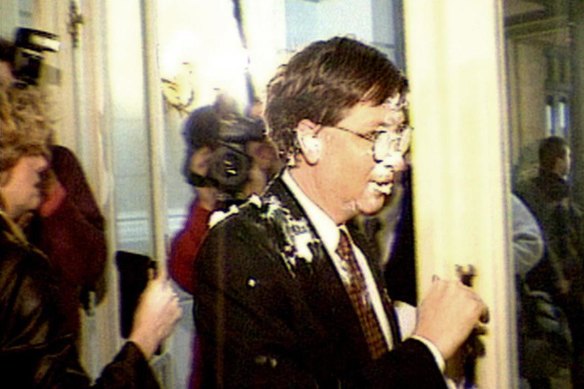
Gates was pelted with custard pies by pranksters on his way to a business meeting in Brussels in 1998.Credit: Getty Images
In 2019, the foundation – whose influence, size and practices had already invited criticism – took an even bigger hit to its reputation when the news emerged, just weeks after Epstein was found dead in his Manhattan jail cell, that Gates had met with the convicted sex offender and paedophile several times. Gates clarified that he had met Epstein purely to discuss philanthropy, and that he was sorry for his poor judgment.
When news of Gates’ ties to Epstein first came tumbling out in 2019, Gates’ media team did what spinmeisters do – they employed a high-visibility strategy that included multiple television appearances, harnessing the press, just as they had after the Microsoft trial in 1998, the biggest antitrust case of the era, in which Gates gave a three-day deposition, and was by turns indignant and contemptuous of questions about Microsoft’s business practices. Gates has always maintained that he met with Epstein because he was told that the financier could connect him with a lot of rich donors who could help raise more money for philanthropic causes.
“I had several dinners with him hoping that what he said about getting billions of philanthropy for global health through contacts that he had might emerge, and when it looked like it wasn’t a real thing that relationship ended,” Gates told CNN’s Anderson Cooper in an interview. “It was a huge mistake to spend time with him, to give him the credibility of being there.”
Gates’ discomfort at being asked about Epstein was obvious in the interview. Every time he was asked about it in a public setting, Gates offered nothing but regrets and apologies, calling it a mistake and blaming it on poor judgment.
In a televised interview in 2021 with Judy Woodruff, then anchor of PBS NewsHour, Gates got visibly shifty and nervous, stammering and fidgeting without providing an iota of information beyond stating his regret and poor judgment, lines that he had delivered repeatedly. When the talk turned to philanthropy, he became much more at ease. In more recent media appearances, Gates has also displayed exasperation about the continual Epstein questions.
This is an edited extract from Billionaire, Nerd, Saviour, King by Anupreeta Das (Simon & Schuster, $35), out next week.
To read more from Good Weekend magazine, visit our page at The Sydney Morning Herald, The Age and Brisbane Times.